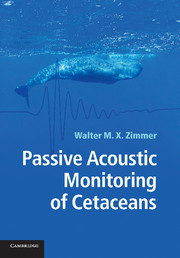Part II - Signal processing (designing the tools)
Published online by Cambridge University Press: 26 April 2011
Summary
This part discusses the algorithms that are needed to detect, classify, locate and track (DCLT) cetaceans. Chapter 4 first presents and discusses techniques that are commonly used to detect signals in passive sonar applications, providing the necessary information for the subsequent signal processing chain. Chapter 5 introduces the concept of classification as a means of reducing erroneous detections, interferences and unrelated detections. The ability to localize animals is addressed in Chapter 6, in which I discuss well-known techniques for passive range estimation: multi-hydrophone ranging, triangulation, multi-path ranging and beam-forming. Tracking is the last component in the DCLT signal processing toolset and is presented together with localization methods in Chapter 6. Considering PAM, tracking plays an important role if one not only tries to localize one or more acoustically active cetaceans, but also tries to monitor their behaviour, which requires tracking, or the continuous estimation of individual animal locations.
- Type
- Chapter
- Information
- Passive Acoustic Monitoring of Cetaceans , pp. 117 - 118Publisher: Cambridge University PressPrint publication year: 2011

